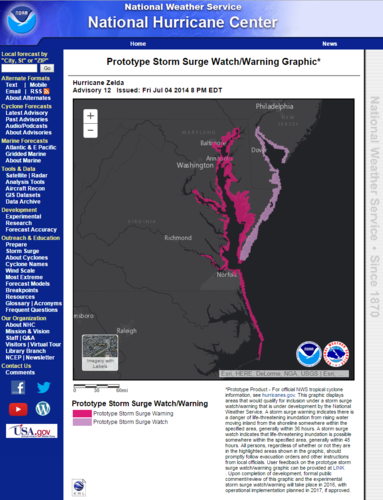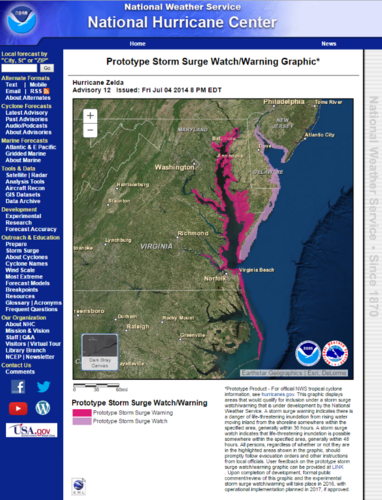Prototype Storm Surge Watch/Warning Graphic
Contents
1. Overview
This information is also available in an NWS Product Description Document (PDF format).
While storm surge is often the greatest threat to life and property from a landfalling tropical storm or hurricane, there is no watch/warning product to highlight the storm surge hazard. Storm surge flooding has accounted for nearly half of the deaths associated with landfalling tropical cyclones over the past fifty years. To help identify and visualize areas most at risk from life-threatening surge, the National Hurricane Center (NHC) will be issuing a prototype storm surge watch/warning graphic beginning in 2015 for tropical cyclones affecting the Gulf and Atlantic coasts of the United States. This graphic is intended to introduce the concept of a separate watch/warning for life-threatening storm surge inundation and serve as a call to action.
2. Product Description
The prototype storm surge watch/warning graphic highlights areas along the Gulf and Atlantic coasts that have a significant risk of life-threatening storm surge inundation from a tropical storm or hurricane, and displays areas that would qualify for inclusion under a storm surge watch/warning under development by the NWS.
The prototype graphic represents the first step of a phased implementation towards an NWS storm surge watch/warning, but for 2015 does not represent an official NWS watch/warning product. The NWS plans to offer the prototype graphic again in 2016, and after incorporating user and partner input, plans to make the storm surge watch/warning fully operational in 2017.
The prototype storm surge watches and warnings are represented by different colors, and their individual definitions are below:
Storm Surge Warning:
A storm surge warning is defined as the danger of life-threatening inundation from rising water moving inland from the shoreline somewhere within the specified area, generally within 36 hours, in association with a tropical, subtropical, or post-tropical cyclone. The warning may be issued earlier when other conditions, such as the onset of tropical storm-force winds, are expected to limit the time available to take protective actions for surge (e.g., evacuations). The warning may also be issued for locations not expected to receive life-threatening inundation, but which could potentially be isolated by inundation in adjacent areas.
Storm Surge Watch:
A storm surge watch is defined as the possibility of life-threatening inundation from rising water moving inland from the shoreline somwhere within the specified area, generally within 48 hours, in association with a tropical, subtropical, or post-tropical cyclone. The watch may be issued earlier when other conditions, such as the onset of tropical storm-force winds, are expected to limit the time available to take protective actions for surge (e.g., evacuations). The watch may also be issued for locations not expected to receive life-threatening inundation, but which could potentially be isolated by inundation in adjacent areas.
What the map takes into account
The experimental Potential Storm Surge Flooding Map is based on the forecast track, intensity, and size of a tropical storm or hurricane. Meteorological uncertainty exists in the forecast, and this map incorporates potential forecast errors by using an existing NWS product developed by the NWS Meteorological Development Laboratory (MDL), in cooperation with the NHC, called Probabilistic Hurricane Storm Surge P-Surge 2.5. P-Surge 2.5 is an ensemble model based on the NWS Sea, Lake, and Overland Surges from Hurricanes (SLOSH) model.
The calculation of P-Surge 2.5 is accomplished by statistically evaluating a large set of SLOSH model simulations based on the current NHC official forecast, and taking into account historical errors in the official NHC track and intensity forecasts. P-Surge 2.5 computes the possible storm surge from each of these alternative scenarios using the SLOSH model and combines the results to calculate a statistical distribution of possible storm surge heights at locations along the coast within the next 80 hours. All the major factors that influence the amount of storm surge generated by a storm at a given location are accounted for, including: the hurricane's landfall location; storm intensity, size, forward speed, and angle of approach to the coast; the shape of the coastline; the slope of the ocean bottom; and local features such as barrier islands, bays, and rivers.
The prototype storm surge watch/warning graphic takes into account:
- Flooding due to storm surge from the ocean, including adjoining tidal rivers, sounds, and bays
- Normal astronomical tides
- Land elevation
- Uncertainties in the track, landfall location, intensity, forward speed, and size of the cyclone
- Flooding inside levees, overtopping of levees, or flooding resulting from levee failures
The prototype storm surge watch/warning graphic does not take into account:
- Wave action
- Freshwater flooding from rainfall
How the prototype storm surge watch/warning graphic is created
The prototype storm surge watch/warning graphic is the result of a collaborative process between the NHC and Weather Forecast Offices (WFOs) and is generated within the Advanced Weather Interactive Processing System II (AWIPS II). Forecaster confidence, continuity from advisory to advisory, and other subjective factors influence the areas highlighted in the prototype storm surge watch/warning graphic.
3. Availability
When is the graphic issued?
NHC will release the graphic approximately 48 hours before the possibility of life-threatening storm surge from a tropical cyclone for areas along the Gulf and Atlantic coasts of the United States. The graphic is subject to change every six hours in association with each new NHC full advisory advisory package. The prototype graphic will be available approximately 30 minutes after advisory time (3, 9, 15, and 21 UTC).
During the prototype period, the storm surge watch/warning graphic will only be available on the NHC website via an interactive viewer: http://www.nhc.noaa.gov/cyclones. The storm surge watch/warning graphic will be disseminated during the prototype period as a KML file.
4. Examples
Note: These are static examples of the prototype storm surge watch/warning graphic. The product itself will be interactive with pan and zoom capability.

|

|
5. Feedback and Comments
The NHC Storm Surge Unit is requesting your comments and feedback on the prototype storm surge watch/warning graphic. During this period, we encourage your comments or suggestions for improvements. Your feedback will help us determine product utility, if modifications are needed, and whether the product should become part of our operational suite.
Please feel free to use any of the methods below for submitting comments.
Mailing Address
For technical questions:
Jamie Rhome
National Hurricane Center
Storm Surge Team Lead
11691 SW 17th Street
Miami, FL 33165
For policy questions:
National Weather Service
Attn: Tropical Program Manager
1325 East West Highway, Room 13124
Silver Spring, MD 20910
Feedback Form



